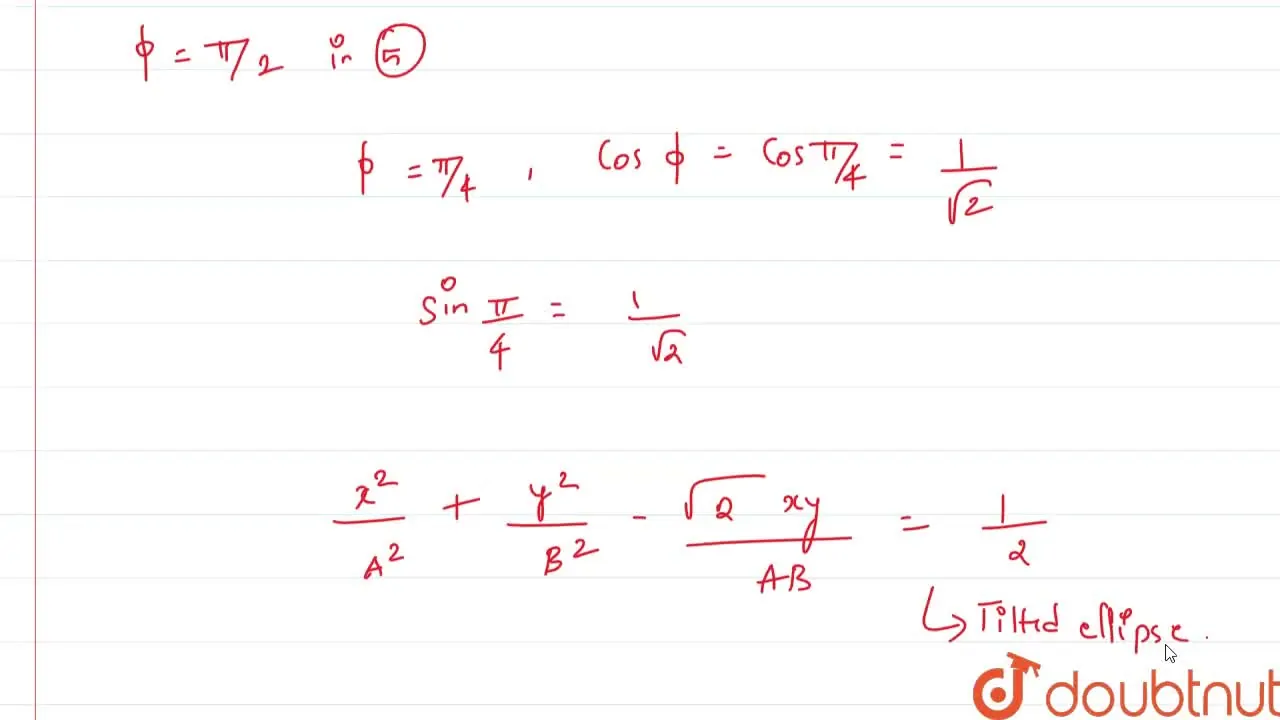Consider two simple harmonic motion along x and y- axis having same frequencies but different amplitudes as x=Asin(ωt+φ) (along x axis) and y=Bsinωt( along y axis).
then show that x2A2+y2B2−2xyABcosφ=sin2φ and also discuss the special cases when
φ=π4
Note : when a particle is subjected to two simple harmonic motion at right angle to each other the particle may move along different paths. Solution in Tamil
Given :
x=Asin(ωt−ϕ) ...(1)
y=Bsinωt ...(2)
In equation (1) use,
sin(A−B)=sinAcosB+cosAsinB
(1) ⇒x=Asinωt.+AϕAcosωt.sinϕx−Asinωt.cosϕ=Acosωtsinϕ
Squaring on both sides we get,
(x−Asinωt.cosϕ)2=A2cos2ωtsin2ϕ....(3)
In equation (2) sinωc can be re- written as, Yb [ from equation (2)]. Also, use,
cos2ωt=I−sin2ωt in equation (3)
∴(3) becomes
(x−AyB.cosϕ)2=A2(1−y2B2)sin2ϕ
On expansion.
x2+A2y2B2cos2ϕ−2xAyBcosϕ
=A2sin2ϕ−A2y2B2sinϕ....(4)
x2+A2y2B2(sin2ϕ+cos2ϕ)−2xyABcosϕ
=A2sin2ϕ (÷byA2)
we get,
x2A2+y2B2⋅1−2xyABcosϕ=sin2ϕ ...(5)
Hence proved.
Special cases :
φ=π4,cosπ4=1√2&sinπ4=1√2 in equation (5) we get,
x2A2+y2B2−(√2)xyAB=12
The above equation is an equation of tilted ellipse.
Related Playlists
- BOOK - PREMIERS PUBLISHERSCHAPTER - OSCILLATIONS EXERCISE - OTHER IMPORTANT QUESTIONS & ANSWERS ( MULTIPLE CHOICE QUESTIONS )64videos
OSCILLATIONS
- BOOK - PREMIERS PUBLISHERSCHAPTER - OSCILLATIONS EXERCISE - OTHER IMPORTANT QUESTIONS & ANSWERS ( VERY SHORT ANSWER QUESTIONS )28videos
OSCILLATIONS
- BOOK - PREMIERS PUBLISHERSCHAPTER - OSCILLATIONS EXERCISE - EVALUATION TEXTBOOK QUESTIONS AND ANSWERS ( LONG ANSWWERS QUESTIONS :)20videos
OSCILLATIONS
- BOOK - PREMIERS PUBLISHERSCHAPTER - NATURE OF PHYSICAL WORLD AND MEASUREMENTEXERCISE - OTHER IMPORTANT QUESTIONS & ANSWERS (III. Short Answer Questions.)24videos
NATURE OF PHYSICAL WORLD AND MEASUREMENT
- BOOK - PREMIERS PUBLISHERSCHAPTER - PROPERTIES OF MATTEREXERCISE - OTHER IMPORTANT QUESTION & ANSWERS (NUMERICAL PROBLEMS)56videos
PROPERTIES OF MATTER
Similar Questions
Assertion : In simple harmonic motion the velocity is maximum when the acceleration is minimum.
Reason : In simple harmonic motion the phase difference between velocity and acceleration is π2
Select the correct option form the following.00:44View SolutionState the values of amplitude and frequency of a particle having the equation of simple harmonic motion as.
01:47View SolutionWhat is meant by simple harmonic oscillation ? Give example
06:38View SolutionWhat is meant by Parallax?
06:01View SolutionA material breaks up under a stress of 20×105N/m2. If the density of the material is 2.5×103kg/m3, calculate the length may break under its own weight.(Take g=10m/s2)
03:03View SolutionTwo simple harmonic motions with the same frequency act on a particle at right angles i.e., along X-axis and Y-axis. If the two amplitudes are equal and the phase difference is pi//2 , the resultant motion will be
04:18View SolutionA particle executing simple harmonic motion along y -axis has its motion described by the equation y = A sin (omega t )+ B . The amplitude of the simple harmonic motion is
04:18View Solutionयदि (If) sinφ=xsin(2θ+φ), साबित करें कि
(x+y)cot(θ+φ)=(y−x)cotθ01:47View SolutionConsider two simple harmonic motion along x and y- axis having same frequencies but different amplitudes as x=Asin(ωt+φ) (along x axis) and y=Bsinωt( along y axis).
then show that x2A2+y2B2−2xyABcosφ=sin2φ and also discuss the special cases when
φ=π2andA=B
Note : when a particle is subjected to two simple harmonic motion at right angle to each other the particle may move along different paths.02:41View SolutionA particle executing simple harmonic motion along - y - axis has its motion described by the equation y=Asin(ωt)+B , the amplitude of the example harmonic motion is
09:57View SolutionA particle is subjected to two simple harmonic motions along x and y directions according to x=3sin100πt, y=4sin100πt.
07:15View SolutionA particle is subjected to two simple harmonic motions along x and y directions according to x=3sin100πt, y=4sin100πt.
05:48View SolutionA particle executing simple harmonic motion along y -axis has its motion described by the equation y=Asin(ωt)+B. The amplitude of the simple harmonic motion is
06:01View SolutionTwo simple harmonic motions with the same frequency act on a particle at right angles i.e, along x and y axis. If the two amplitudes are equal and the phase difference is (pi)/(2) the resultant motion will be :
06:01View SolutionConsider two simple harmonic motion along x and y- axis having same frequencies but different amplitudes as x=A sin (omegat+varphi) (along x axis) and y= B sin omega t ( along y axis). then show that (x^(2))/(A^(2))+(y^(2))/(B^(2))-(2xy)/(AB) cos varphi = sin^(2) varphi and also discuss the special cases when varphi=0 Note : when a particle is subjected to two simple harmonic motion at right angle to each other the particle may move along different paths.
02:17View Solution


